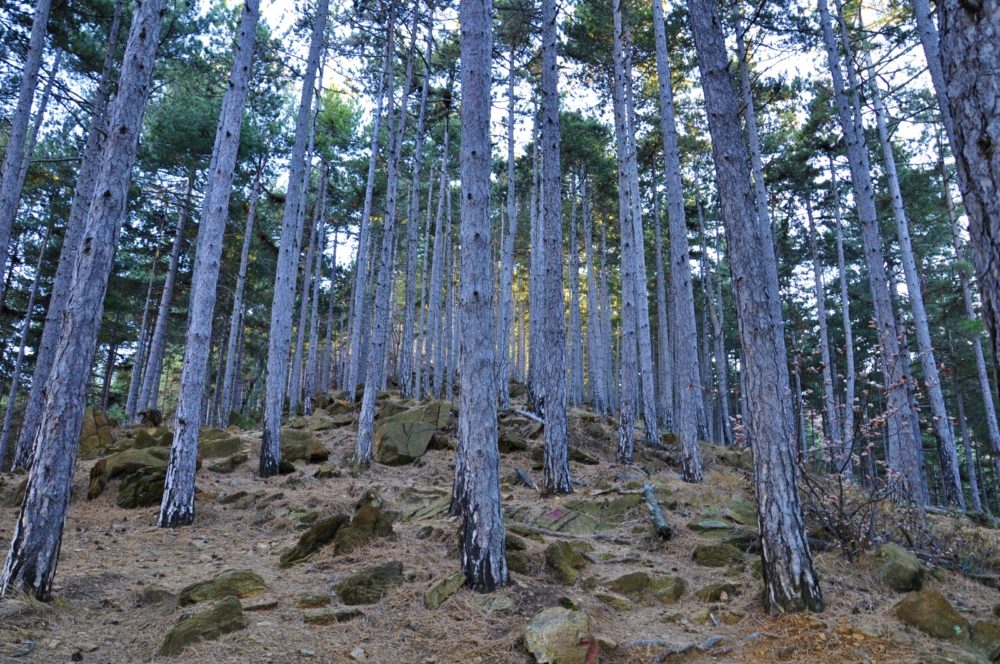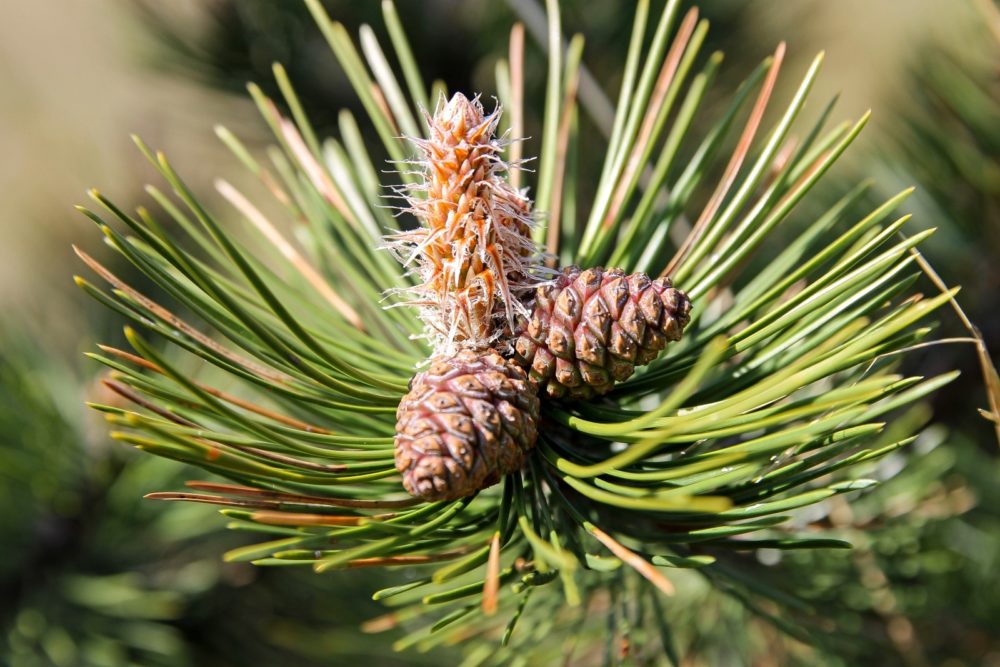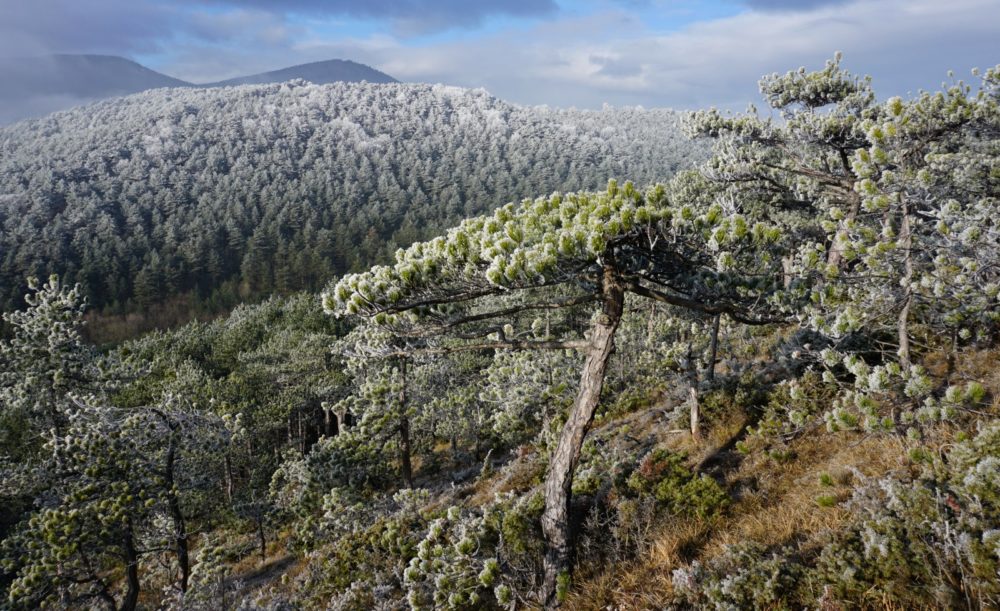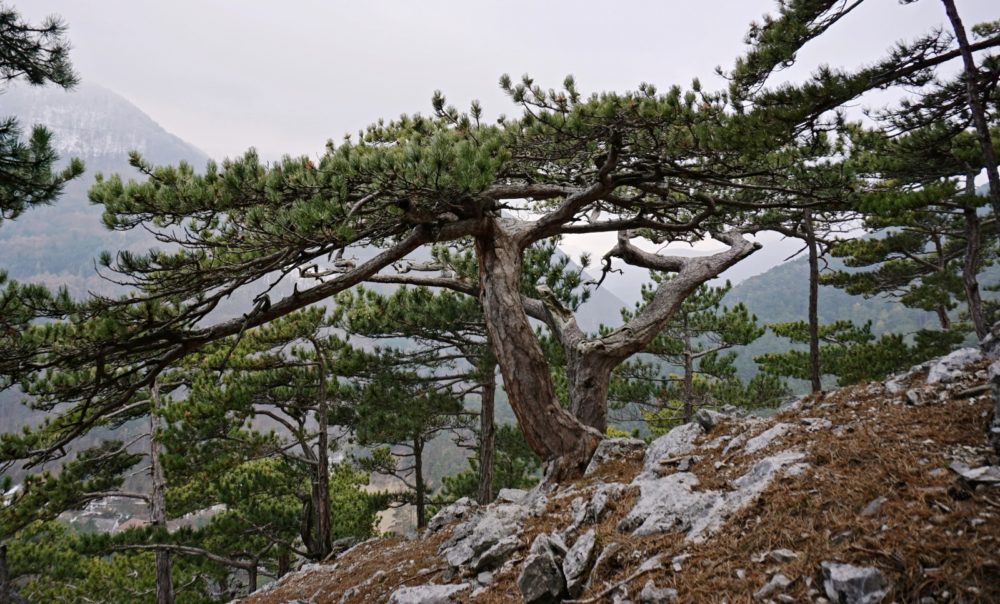Can black pine be a perspective tree species, in the Czech Republic?
One of the non-native tree species, with which we have long-term experience in the Czech Republic is black pine, which comes from Southern Europe. When using a suitable provenance, scientists consider this tree species to be a perspective one for the changed climatic conditions in the Czech Republic from the point of view of forestry use, if future legislation does not include it among invasive non-native species.
 The negative impact on biodiversity is usually more noticeable in non-native tree species that come from geographically distant regions. However, this effect is not significant in the case of the black pine that grows in the Czech Republic. In fact, in certain specific situations such as the reclamation of former roadside landings, it can even improve soil fertility. Currently, the European black pine vegetation area in the Czech Republic is 3,490 hectares with a growing stock of 803 611 m3 and an average age of 96.58 years.
The negative impact on biodiversity is usually more noticeable in non-native tree species that come from geographically distant regions. However, this effect is not significant in the case of the black pine that grows in the Czech Republic. In fact, in certain specific situations such as the reclamation of former roadside landings, it can even improve soil fertility. Currently, the European black pine vegetation area in the Czech Republic is 3,490 hectares with a growing stock of 803 611 m3 and an average age of 96.58 years.
The black pine is a coniferous tree species that can be found in a natural area of about 3.5 million hectares spanning North Africa, Southern Europe, and so-called Asia Minor. Its northernmost natural occurrence is in Austria. In Southern Europe, it is the most economically important domestic conifer and is often planted outside its original area. Six main subspecies of the black pine have been distinguished.
The black pine is a type of tree species, which can grow on various types of soil, from limestone and marble to acidic and volcanic soils. It does not tolerate shade and is susceptible to fires. However, it is resistant to wind, drought, and to some extent, frost. The Austrian black pine is particularly well-suited to Central European conditions and has minimal water requirements. It is long-lived and relatively resistant to wind. In contrast, fast-growing provenances from Corsica and Calabria do better in other regions. Due to climate change, the black pine is likely to become more prevalent in the future.
 Scientists do not consider the resistance of black pine to drought to be strictly linked to the location of origin, and therefore to support adaptability. For these reasons why, they recommend using natural regeneration or a mixture of several genotypes instead of choosing one optimal provenance source. This tree species also has landscape and other uses.
Scientists do not consider the resistance of black pine to drought to be strictly linked to the location of origin, and therefore to support adaptability. For these reasons why, they recommend using natural regeneration or a mixture of several genotypes instead of choosing one optimal provenance source. This tree species also has landscape and other uses.
The black pine in the Czech Republic is struggling to regenerate within its natural habitat, and can also become invasive outside of its natural range. In our conditions, sedges are a frequent cause of death for the pine, and they have been suffering from drying out due to temperature extremes and dry spells. This drying out can lead to complete withering after a few years if it becomes acute. Weakened pine trees are also more susceptible to other pests.
Scientists note several positive characteristics of black pine, including similar production to that of Scots pine, wide use of wood, tolerance to various soil types, emissions, drought, wind, and frost (except for early frosts). The black pine also shares a similar spectrum of biotic pests with the Scots pine and can be applied in mixtures with the main economic trees. Additionally, the black pine has a frequent and good crop of seeds with high germination.
The black pine has low resistance to severe impacts on the herbaceous layer and may.
Provenance trials enable an impartial evaluation of the growth responses of progenies from geographically distant populations to diverse planting site environments. Modern forestry requires knowledge of appropriate areas of origin of reproductive material to ensure the production of high-quality raw wood material and sustain the stability of stands under expected variable ecological conditions during harvesting.
 In a given case, the subject of the research was the evaluation of the growth of nine provenances on a long-term research area with black pine in Central Bohemia at research plot No. 41 – Roblín, which is located in the Bohemian Karst.
In a given case, the subject of the research was the evaluation of the growth of nine provenances on a long-term research area with black pine in Central Bohemia at research plot No. 41 – Roblín, which is located in the Bohemian Karst.
This provenance experiment was evaluated by scientists from FGMRI (VÚLHM, v. v. i.), Department of Forest Tree Biology and Breeding. The obtained results were published in the paper Evaluation of the growth of European black pine (Pinus nigra Arnold) provenances in Central Bohemia at the age of 51 years /Zhodnocení růstu proveniencí borovice černé ve středních Čechách ve věku 51 let/, which was issued in the journal Reports of Forestry Research 4/2024.
The experiment was established in 1971 to verify selected provenances in the Czech Republic. These provenances include those from Austria’s Viennese Forest, the former Yugoslavia, Greece, Bulgaria, Romania’s Banát, Italian Calabria (known for fast growth, good production, good stem form, and relative resistance to frost), Corsica (with soils on weathered acidic rocks), the proven cultural provenance of Koekelare from Belgium, and the domestic provenance from Bohemian Karst.
According to the current research, a total of 306 pine trees at the age of 51 have been measured in the research plot. However, this number is 101 fewer than the data from 10 years ago. The trees in this area have been dying since 2009-2011. Many trees also exhibited signs of deteriorating health during that time.
 French provenance No. 9 (20.0 m) and Serbian No. 2 (19.3 m) were characterized by the highest height growth. The Greek provenance No. 8 (18.9 m) and the Bulgarian one No. 7 (18.8 m) also reached above-average heights. The greatest increase in DBH was found for Greek provenance No. 8 (25.6 cm), French No. 9 (25.3 cm), and Bulgarian No. 7 (24.8 cm). The straightest stems were found in the case of Bulgarian provenance No. 7, followed by French No. 9 and Serbian No. 2. French provenance No. 9, Bulgarian No. 7, Serbian No. 2, and Greek No. 8 excelled in terms of health status.
French provenance No. 9 (20.0 m) and Serbian No. 2 (19.3 m) were characterized by the highest height growth. The Greek provenance No. 8 (18.9 m) and the Bulgarian one No. 7 (18.8 m) also reached above-average heights. The greatest increase in DBH was found for Greek provenance No. 8 (25.6 cm), French No. 9 (25.3 cm), and Bulgarian No. 7 (24.8 cm). The straightest stems were found in the case of Bulgarian provenance No. 7, followed by French No. 9 and Serbian No. 2. French provenance No. 9, Bulgarian No. 7, Serbian No. 2, and Greek No. 8 excelled in terms of health status.
In the overall assessment in terms of quantitative and qualitative traits, the best were French provenance No. 9 – Les Barres, Oise, which excelled in height and DBH, health status, and stem form, and Serbian provenance No. 2 – Crni Vrh, Titovo Užice, which was, apart from growth rate, stem form, and health status were positively assessed also in the thickness of the main branches.
Research shows that black pine can thrive in drier and warmer locations in the Czech Republic with suitable provenance selection.
The declining health of the black pine has become more apparent in recent years, suggesting that we need to be cautious when making recommendations for its future use. To be able to withstand the negative impact of harmful agents and survive until the rotation age, the tree needs to be in good health (with a low defoliation rate).
It has been confirmed that provenances reaching larger dendrometric parameters (height and DBH) have lower defoliation at the same time, i.e. they also have a higher resistance potential.
The paper was prepared during the NAZV QK22020045 project solution.
The paper Evaluation of growth of European black pine (Pinus nigra Arnold) provenances in Central Bohemia at the age of 51 years /Zhodnocení růstu proveniencí borovice černé ve středních Čechách ve věku 51 let/ can be downloaded here.
Authors of paper: Petr Novotný, Jiří Čáp, Martin Fulín, Jaroslav Dostál, FGMRI (VÚLHM, v. v. i.), e-mail: pnovotny@vulhm.cz
According to the original, prepared by: Ing. Jan Řezáč, FGMRI (VÚLHM, v. v. i.), email: rezac@vuhm.cz
Illustrative photos: Black pine
